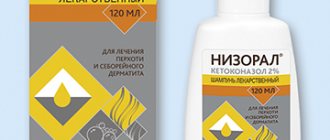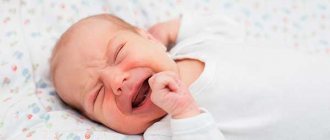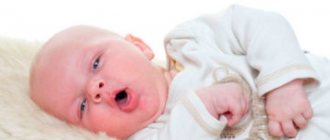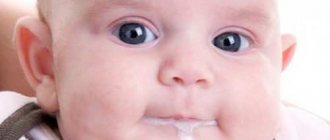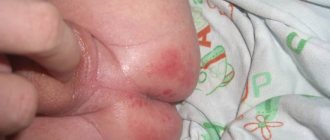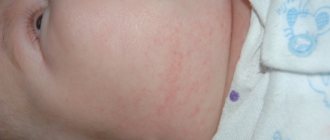Causes of rashes
Children's rash can appear on the head, face, arms, legs, neck, back, chest, butt, stomach, elbows, and genital area. The location of pimples, as well as their character, depends on the type of disease that provoked them. The most common causes of pathological changes in the skin are the following factors:
- Disturbances in the composition of the blood. When blood clots poorly, small hemorrhages appear on the skin. This is most typical for meningococcal meningitis.
- Diseases of viral etiology. This group includes measles, chickenpox, infectious mononucleosis, and rubella.
- Bacterial pathologies. A prominent representative is scarlet fever.
- Mechanical factors. If the dermis is damaged, the child may develop a rash in the form of small red dots, blisters, pimples, red or pink spots.
- Allergy. Often, a rash in children appears as a result of insect bites, when the dermis is exposed to household chemicals and some cosmetics. Skin irritation often occurs when eating allergens. Rashes may appear as a response to the use of medications.
From the list it is clear that there are quite a few reasons for this condition.
In addition, in many pathologies the rash has a very similar character. Therefore, do not try to independently diagnose a particular condition in your child. This should be done by an experienced dermatologist.
Common Causes
When rashes appear, parents should monitor the baby’s condition and identify accompanying symptoms.
Before visiting your pediatrician, you need to find out the following:
- Do the rashes cause any discomfort (itching, pain, peeling, etc.).
- Damage area.
- Body temperature.
- Other complaints of the child.
The appearance of rashes can be triggered by various factors, since children often experience allergic reactions and a weakened immune system.
Common causes of a rash on a child's body:
- Allergic reaction. Common manifestations are small, watery pimples on the legs and hives. Dermatitis of allergic origin is accompanied by itching of the affected area. There is an allergy to cold. It appears as large red spots located on the thighs. Allergies can be caused by: animal fur, foods, medications.
- Infectious diseases. Rarely found in children under 2 years of age. Such diseases include:
- measles - small red blisters localized throughout the body; accompanied by elevated body temperature, runny nose, cough;
- scarlet fever - a rough red rash; manifested by redness of the tongue, vomiting, feeling of heat;
- rubella - small pink pimples; accompanied by an increase in body temperature;
- meningococcus - blue rash in the shape of stars; occur together with painful sensations in the joints, nausea, fever, anxiety, pain when swallowing;
- chicken pox – blisters filled with clear fluid that affect the entire body; the rash itches and is accompanied by an increase in temperature;
- pseudotuberculosis - a red rash located on the feet; manifests itself together with painful sensations in the abdomen, diarrhea, high fever;
- vesilocupustulosis - small ulcers; sometimes body temperature rises to 37.3 degrees;
- vesicular stomatitis – small pimples with a red halo form; the oral mucosa is affected;
- enterovirus - rashes appear on the inside of the foot; headache, nausea, vomiting, and bowel dysfunction occur together.
- Pathologies of the vascular system. Rashes can occur due to poor blood clotting. This occurs due to decreased platelet levels and vascular fragility. The rash is called hemorrhagic and can appear in the form of dots, spots, stripes from reddish to purple. Such rashes do not cause discomfort to the child, but after they disappear, spots appear, which are accompanied by itching and peeling of the affected areas. The rash may occur due to the disease vasculitis, which affects the vascular system.
- Hormonal changes in the body. With the pathology in question, white rashes form. As a rule, they are temporary. The affected areas do not cause itching, but may become inflamed.
- Infection with parasites. Papules are formed due to the penetration of scabies mites into the body and are accompanied by severe itching. In addition, rashes can be caused by worms. As a result of the vital activity of parasites in the gastrointestinal tract, acne, boils, and urticaria appear. When helminths lay eggs, hard nodules form on the skin. Infection can occur from cat, dog, and insect bites.
- Insufficient hygiene of the baby's body. Due to increased sweat production in the heat, failure to comply with personal hygiene rules, and wearing synthetic clothing, prickly heat may occur. A more serious consequence of poor hygiene is fungal disease on the feet. The infection starts at the toes and then spreads to the entire foot. A white rash forms that itches and peels. Over time, an unpleasant odor develops.
Parents should know all the information about the main signs of pathology in order to promptly seek medical help.
Photos of some types of rashes in a child:
Associated diseases
Prickly heat
A disease characterized by the formation of small blisters or pimples. It is provoked by elevated temperature, steaming the body with warm or synthetic clothing that does not allow air to pass through. It often occurs in the groin area, in the folds under the knees, and in the armpit area.
Miliaria is distinguished:
- papular (associated with the appearance of papules: the skin becomes very dry, peels and itches),
- red (distinguished by red blistering and nodular formations up to 2 mm with cloudy liquid inside, itching),
- crystalline (characterized by the presence of white and transparent bubbles with a diameter of up to 1 mm.).
Treatment of the disease is associated with the elimination of provoking factors (overheating) and compliance with the necessary hygienic conditions.
You can relieve the symptoms of the disease with the help of creams and gels: “La-Cri” (safe for infants, pregnant women), “Bepanten”, etc.
Hormonal imbalance and vitamin deficiency
Changes in hormonal levels (during puberty, in case of disturbances in the functioning of internal organs involved in the production of hormones) can cause acne to appear on the legs. The disease manifests itself individually, and peeling of the skin may occur.
Vesiculopustulosis
An infection that is characterized by the appearance of watery small blisters with a clear liquid inside, which turns into pus over time. It is caused by pathogenic staphylococcus. Sweat glands are affected (on the head, in the folds of the abdomen, legs, arms, buttocks). Newborns with weakened immune systems are susceptible to the disease.
Allergic reaction
It appears in the form of watery acne, transparent or white, and is a response to exposure to household chemicals and food. It is treated by eliminating the provoking factor. Signs can be relieved with antiallergic creams and ointments.
Measles
An infectious disease characterized by the appearance of large pimples all over the body, capable of bursting and merging with each other, forming a crust. Symptoms are supplemented by high temperature (38-40 degrees), the child is shivering, has a runny nose and cough.
Chickenpox
Characteristic is the appearance of watery rashes on the limbs, torso, and head, accompanied by severe itching.
Scarlet fever
There is a high temperature, redness of the tongue and throat. A red rash, rough to the touch, covers the entire body.
Diaper dermatitis
Irritation that occurs in infants in the groin area due to prolonged use of a diaper and overheating of the problem area. Relieve symptoms with creams and ointments, sea buckthorn oil, and air baths.
Irritation may occur due to insect bites. The skin in these places begins to itch and blisters appear. They go away on their own in a few days. It is important to protect the area from scratching.
1 Infectious and non-infectious causes
The reasons for the appearance of a rash on the legs of a baby are very diverse. The opinion that a baby should not have any vascular diseases, and that mother’s milk protects him from allergies, is erroneous. And food allergies can appear at any age, and immunity only lasts for a couple of months. So a rash should be a reason to see a doctor, because only a specialist can determine the cause of its appearance.
Many parents are afraid that rashes on their child’s legs are a symptom of an infectious disease. Indeed, with measles, rubella and meningococcal infection, a rash appears on the legs. But with measles, it first appears behind the ears and on the upper chest and only then, after 2-3 days, begins to spread throughout the body. It is precisely this phasing that indicates that it is measles, since other signs are characteristic of other infectious diseases.
Rashes in children are caused by the following diseases:
- 1. Scarlet fever. The rash looks like red, rough spots, localized not only on the legs, but also on other parts of the body. Additional symptoms are high fever, redness of the tongue.
- 2. Chicken pox. With it, rashes appear first on the scalp, so parents often do not notice them until they begin to spread throughout the body. The rashes look like pimples with clear liquid. The affected areas of the skin are very itchy.
- 3. Measles is a dangerous infectious disease that causes red rashes that look like pimples. Accompanied by a runny nose, cough and fever.
- 4. Rubella is a disease in which a small pink rash appears (first on the face, and then on the legs and buttocks). Symptoms of intoxication are less pronounced than with measles.
- 5. Enterovirus infection. With it, the rash is most often observed on the feet. It doesn't cause much discomfort.
Of the non-infectious causes of the symptom in question, allergies are the most common. It usually develops as a reaction to an eaten product. Even cow's milk protein can cause an allergy in a baby who is several months old. This reaction occurs more often in those children who were transferred to artificial nutrition. But an allergy in a baby also occurs when he is breastfed, and an allergen gets into the mother’s milk (if the mother ate chocolate, orange, strawberries, etc.). This rash is very itchy and the child becomes irritable. But there are no symptoms of general intoxication. Treatment usually comes down to eliminating contact with the allergen and following a certain diet. Such children need to be more careful when introducing complementary foods. Older babies, who are already one year old, exclude baked goods made from wheat, red berries and fruits from their diet.
Among the non-infectious causes of the appearance of a rash, several more can be named:
- 1. Heat rash. It occurs in folds of skin, on the neck and under the arms. It is also localized under the knees. The reasons are overheating and insufficient skin care. The same factors provoke diaper dermatitis, only with it the rash is more localized between the legs.
- 2. Psoriasis. A disease whose causes are still debated by doctors. Many researchers highlight a hereditary factor, others talk about disturbances in the functioning of the central nervous system. Psoriasis manifests itself as a rash in the form of red spots that are localized on the knees.
- 3. Insect bites. They cause different skin reactions. Sometimes these are small red pimples located almost in a row - this is what bedbug bites look like. With scabies, the rash is of a paired nature; the entrances and exits of the mite to the surface are visible.
Whatever causes the rash in a child, it is not the symptom that is treated, but the cause that caused it. For allergies, antihistamines are prescribed. Infants can be given drops or ointments from the same category (if the rash has a small area of distribution).
Types of rashes
The disease manifests itself as:
- bubbles (they are blisters containing a clear liquid),
- pustules (characterized by the content of pus),
- milia (appear as small, colorless bumps that are not accompanied by pain),
- papules (skin lumps),
- nodules (subcutaneous formations accompanied by pain).
Can be:
- inflamed (large, red, with purulent contents),
- non-inflamed (black dots).
If, when a rash appears on the legs, a child experiences vomiting, drowsiness, swelling of the face, shortness of breath and other symptoms, then you should immediately consult a doctor in order to make an accurate diagnosis and prescribe the correct treatment.
Small red rash in the form of dots
Small, pinpoint red rashes on the extremities are a common manifestation of allergies (legs, feet, and palms are affected). Also, similar symptoms characterize miliaria (when the rash forms locally on the legs, but is absent on other parts of the body, it occurs due to overheating of the body). Changes in the skin may appear due to a fungal infection, psoriasis, scabies, or lupus. If redness is observed all over, you can suspect rubella (characterized by enlarged lymph nodes) or measles (in addition to redness of the skin, this disease is accompanied by an increase in temperature, and signs of ARVI are observed).
Discolored white rash on legs
Such rashes characterize the manifestation of an allergic reaction, the presence of a fungal infection, problems with the digestive system, and may signal a lack of hormones in the child’s body or a lack of vitamins.
Large rash
Initially small, and subsequently increasing in size, star-shaped pimples on the child’s legs and torso signal an infection of the body with meningococcus (a bacterium that parasitizes the blood and can lead to sepsis). Rashes that occur in very young children are extremely dangerous, as they can lead to serious complications.
If a similar rash appears exclusively on the flexor surfaces of the legs, then this indicates an infection with scabies mites. The disease is accompanied by itching of the infected areas.
Pimple-like rash
The appearance of acne on a child's legs can be caused by:
- teething,
- allergies,
- prickly heat,
- exposure to the drug (reaction to vaccination),
- skin contaminations,
- chapping, sunburn,
- streptoderma (characterized by the presence of red, watery pimples due to streptococcal infection),
- infectious diseases,
- intestinal dysbiosis,
- diabetes (characterized by the appearance of a rash on the buttocks),
- hormonal changes.
Rough dry rash
This sign appears when a child gets scarlet fever (a disease characterized by intoxication, fever, general weakness, redness of the tongue and throat, accompanied by a rash). The area of skin damage covers not only the lower extremities, but also other parts of the body. The disease is infectious in nature and is transmitted by airborne droplets.
Dry, rough rashes are also characteristic of atopic dermatitis caused by allergies. For effective treatment, it is necessary to eliminate contact with the allergen, use antihistamines, and the skin can be treated with baby cream or Bepanten.
Rash on the soles of the feet
Acne appears on a child’s feet for the following reasons:
- vesicular stomatitis (also occurs on the mucous membrane of the patient’s mouth),
- pseudotuberculosis (a rash appears on the feet and hands, accompanied by abdominal pain, fever, diarrhea),
- contact with prickly and stinging plants (nettle, thorns; symptoms are relieved by baths with chamomile, string, calendula).
Differential diagnosis of rash of infectious origin
| Hidden period | Symptoms | Rash | Period of infectiousness and vaccination | |||
| View | Time and order of appearance | Footprints | ||||
| Measles | 10-12days |
| Large maculopapular, bright, may merge | After 3-5 days of illness - behind the ears, along the hair. Then it goes down to the feet (in three days) | Bruising and peeling | 4 days before the first rash and up to 5 days after it disappears. Vaccination - at 1 year, 6 years |
| Rubella | 2-3 weeks |
| Finely spotted, pale pink | On the first day of illness on the face, after 24-48 hours - throughout the body, disappears after 3 days. | Disappears without a trace | Contagiousness during the period of rash, a few days before and after it. Vaccination -12 months, 6 years |
| Scarlet fever | 2-7 days |
| Fine-dot (1-2 mm), bright | Simultaneous rash, intense rash in the folds of the body. Pale nasolabial triangle. | Leaves peeling | contagiousness 10 days from the onset of symptoms, with streptococcus carriage - constant contagiousness |
| Infectious mononucleosis | Unknown |
| Diverse in shape and size, does not always occur | On the 5-6th day of illness, sometimes later. More intense on the face, but also present on the body | Disappears without a trace | The virus is low infectivity and is transmitted more often through sharing utensils and kissing |
| Erythema infectiosum | 4-28 days |
| Red spots | Red spots from the face spread to the entire body, especially to the extensor surfaces. Before disappearing, they take on the appearance of a ring with a white center. | Disappear for a long time, can reappear within 3 weeks under unfavorable conditions | Children are usually not contagious once the rash appears. |
| Sudden exanthema | 5-15 days |
| Fine spotted | The spots appear after the temperature on the body normalizes. | Disappears within a few hours or days without a trace | Infection most often occurs from adults who are carriers of herpes virus type 6 |
| Chicken pox | 10-21 days |
| Spots, papules, blisters and crusts. | The beginning is on the scalp, face, torso. Then it spreads to the whole body. Different elements of the rash are present simultaneously. | there are no traces, but if an infection occurs when scratching, scars may remain | 48 hours before the rash appears and before crusts form on all elements (up to 2 weeks). It is planned to be included in the vaccination calendar in 2015. |
| Meningococcal sepsis | — |
| From small bruises to extensive hemorrhages | More often - the lower limbs and torso. | Extensive hemorrhages can develop into ulcers and scars. | Throughout the illness |
Causes of rash in infants
Facial rashes in newborns can occur for many reasons. Let's look at the most common ones.
Growth and adaptation of the body
- Milia. A small white or yellowish rash on the nose, cheeks and chin occurs in half of newborns and goes away on its own within the first month of life.
- Acne of newborns. A colorless or red rash on the cheeks of a baby (sometimes around the eyes, forehead and nose) indicates the formation of a hormonal background and goes away on its own within a few weeks. Only in rare cases do such acne indicate a hormonal imbalance.
- Irritation. When the time comes for teething, the baby begins to salivate profusely. Because of this, the child often develops a pinpoint rash on the chin.
- Toxic erythema. A rash in the form of red spots with small white or yellow blisters appears in infants around the joints, on the chest and abdomen. This phenomenon usually occurs on days 2-4 of life. The child may be bothered by the itching, but this will go away within a few days. This phenomenon is not dangerous to health and indicates the child’s adaptation to the external environment.
- Seborrheic dermatitis. A yellowish rash in newborns in the form of greasy or hard scales on the face and head is quite common and goes away on its own within a year.
Wrong care
- Prickly heat. A red rash on a baby's neck, which can turn into small white pimples, may indicate that the baby is overheated. This happens in hot climates or simply among parents who are always afraid that their child will freeze. If, at the first signs of heat rash, the child continues to be wrapped, then the rash in newborns can spread to all natural folds of the skin and the head. As soon as the child gets into normal climatic conditions, prickly heat quickly disappears.
- Diaper rash. Red small pimples on the butt, in the groin folds and in the genital area (sometimes also in the armpits and on the neck) may indicate improper hygiene (rare bathing, untimely changing of the diaper) or a fungal infection.
- Diaper dermatitis. As a rule, it is a consequence of improper care of the baby and manifests itself as red merging spots on the folds of the neck, buttocks, and genital area. Then small papules (bubbles) appear, the skin begins to peel off, wounds and erosions appear. If measures are not taken in a timely manner, staphylococcal and fungal infections may occur.
Allergy
- Allergic dermatitis, urticaria. A red, scaly rash on the baby's face, which gradually spreads to the ears, neck, back, chest and stomach, is most often a sign of an allergy. The reason may be the diet of a nursing mother (the presence of allergens in the diet such as seafood, peanuts, strawberries, etc.), inhalation of dust or dander from pets, a reaction to washing powder, to foods in complementary foods, to medications. Sometimes a colorless rash can indicate an allergy. For example, with lactase deficiency (allergy to whole milk).
- Atopic dermatitis (eczema). A red itchy rash on a baby's body appears before the age of 6 months and is usually associated with an allergy to milk and egg whites (eaten by the nursing mother or the baby itself). First, elements of the rash appear on the face, scalp and torso, and as the child gets older, they can appear in the natural folds of the skin, in the popliteal cavities and elbow bends.
Infections
- Impetigo. A skin disease that manifests itself as painful red spots around the mouth, nose, arms and legs. This is a highly contagious disease that most often affects infants, but it is easily treated with antibiotics.
- Scabies. This problem can occur at any age, and it cannot be avoided without the help of a doctor. A small itchy rash in infants spreads throughout the body, including the soles of the feet. The disease can be treated with special creams or sprays, but all family members should be treated.
- Measles. If a red rash on the face of a month-old baby is combined with a high fever (about 38 degrees), swelling under the eyes, cough and runny nose, these may be signs of measles. See your doctor as soon as possible.
- Varicella (chickenpox). The disease begins with one small red spot, on which a blister appears within a few hours. There can be from a few to hundreds of such elements. The child may have elevated body temperature, nausea, muscle pain, and loss of appetite. Consult your doctor for clarification of the diagnosis.
Pimples on a child’s legs: types, methods of treatment on the hands, which ones are dangerous
Caring parents immediately notice physiological and psychological changes in their child. Pimples on the legs of children indicate the presence of a pathological process.
Based on the nature of the rash, the cause is determined, but this, as well as the prescription of treatment, should be dealt with by a pediatrician.
8 reasons why pimples appear on the arms and legs of children
The child’s immune system is poorly formed; even minor exposure to negative factors causes a pathological reaction.
There are many reasons for the appearance of rashes; they are conventionally divided into 8 groups:
- Lack of hygiene can be considered the main reason for the development of pathologies that cause rashes.
- Poor nutrition. The sudden introduction of new products and an unbalanced diet cause an immunopathological reaction. Rashes of various locations appear, accompanied by itching.
- Allergy. In babies under one year of age, an allergic reaction is often caused by lactose intolerance. Blisters and redness can appear when taking medications, insect bites, or constant contact with synthetic materials and dyes. The immunopathological process in boys and girls is often caused by infection with worms.
- Dermatological diseases. Diaper dermatitis occurs in newborns. It manifests itself as redness of the skin, later pustular elements appear. Prurigo (prurigo) is often diagnosed before the age of 5 years. Blood nodules with small blisters inside appear on the extensor parts of the arms and legs.
- Fungal diseases. The nature of the rash depends on the type and ability of the infectious agent to infect the body. The most common disease is microsporia. Characterized by small bubbles that develop into large spots. Candidiasis is no less rare. The disease is accompanied by vesicular rashes and itching.
- Bacterial infections: dysbacteriosis, vesiculopustulosis, scarlet fever.
- Viral infections. Measles begins with a fever; after the temperature drops, a rash appears, first on the head, then spreading to the whole body. With chicken pox, pimples appear in the form of blisters that burst after 3-4 days.
- Vascular pathologies. Hemorrhagic vasculitis is characterized by high fever, small red pimples on the legs and thighs. With periarteritis nodosa, a maculopapular rash and nodules on the skin in the forearms and thighs are observed.
Only a doctor can determine the exact cause based on a physical examination and test results.
Types of rashes in children
Baby's skin reacts differently to the presence of allergens and pathogenic microorganisms.
- Red dots are usually a reaction to an allergen. In babies under one year old, the appearance of such symptoms may be associated with the introduction of new products and lactose intolerance. Red and pink small elements are also observed with rubella.
- Blisters (watery pimples) cause bacterial (scarlet fever, streptoderma) and viral (chickenpox, lichen) infections. Watery elements can be a symptom of pemphigus - an autoimmune pathology or prickly heat - a disease caused by poor hygiene.
- Large spots. An enlarged rash occurs with measles, erythema, pityriasis rosea, and insect bites. Initially small spots quickly increase in size, often accompanied by itching and painful sensations when touched. Failure to seek medical help in a timely manner may result in the development of sepsis.
- A rough rash is caused by fungal infections: candidiasis, lichen versicolor. White scales and serous crusts are visible in the affected area.
- Colorless whiteheads are characteristic of vitamin deficiency or keratoses.
- An itchy rash occurs due to allergies or insect bites.
A number of pathologies are characterized by several types of rash; the diagnosis is made taking into account all the symptoms.
Main locations
When making a preliminary diagnosis, not only the nature, but the location of the pustular elements is important:
- Red spots and blisters on the wrists and palms are typical when the body is affected by bacterial infections.
- Pustular elements between the fingers are caused by scabies and mite bites.
- Fungal diseases affect the phalanges of the fingers and toes.
- Spots and pustules on the bends of the limbs may indicate dermatological pathologies of a non-infectious nature.
- Papular elements on the thighs and legs can develop as a result of meningococcemia and pathologies of the circulatory system.
If hygiene and allergies are not observed, pathological manifestations are observed throughout the body.
Be sure to read:
Basic signs about a pimple on and around the nose
What to do if you find pimples on your child’s arms and legs?
If you notice unusual occurrences, you should not panic. Initially, the patient is examined, assessing the nature of the rash. They ask about your health, the presence of additional clinical manifestations (diarrhea, pain, thirst), and take your temperature. For fever, medications based on paracetamol or ibuprofen are given.
Citrus fruits, red vegetables and fruits are removed from the diet, and protein foods are minimized. Change bedding, limit contact with potential allergens as much as possible: animals, synthetic material. Antihistamines are given according to age. If the condition suddenly worsens, seek emergency medical care.
Treatment of rashes on arms and legs
Treatment tactics are determined depending on the cause and clinic.
To eliminate the vast majority of pathologies that cause pustular formations, drug therapy is used.
- Anti-inflammatory dermatoprotective agents for external use (Bepanten, Dexpanthenol).
- Glucocorticosteroid ointments, gels (Advantan, Comfoderm, Betamethasone).
- Antihistamines (Zodac, Zyrtec).
- Antiviral agents (Ciclovir, Valvir).
- Immunomodulators (Ergoferon, Anaferon, Isoprinosine).
Symptomatic therapy is carried out using NSAIDs, antidiarrheals and other drugs. Treatment with medications in childhood should be prescribed and carried out under the supervision of a physician.
Preventive measures
It will not be possible to completely protect your son or daughter from the effects of negative factors.
But a number of preventive measures taken will help avoid the appearance of acne:
- Maintaining hygiene. Newborns are washed after each toilet, napkins are used when water procedures are unavailable, and preference is given to hypoallergenic ones. Keep your hands clean, especially after walking.
- General vaccination against measles (lifelong immunity to it is formed) and other infectious pathologies is carried out.
- They monitor their diet and watch the body’s reaction to eating new food. When choosing products, the individual food intolerance of the baby and genetic parents are taken into account - food allergies are often inherited.
- When traveling into nature, insect repellents are used. The skin is treated with repellents or special bracelets are worn.
- Anthelmintic prophylaxis is carried out every six months.
- Regularly undergo preventive medical examinations.
Be sure to read:
Signs about pimples on and near the lips
If you have any doubts or worsening health conditions, consult a doctor.
For which rash should you see a doctor?
Any manifestations on the skin indicate a health problem. In all children, the protective functions of the body are developed differently. If acne occurs in newborns, seek medical advice as early as possible. Secondary infectious diseases quickly join common diaper dermatitis.
Parents, sons and daughters who attend kindergartens and schools when symptoms appear should be aware of the presence of an epidemic of chickenpox, measles and other infections in the institutions. Diseases are transmitted through contact of an infected person with a healthy person. If uncharacteristic manifestations occur during quarantine. The baby is immediately taken to a specialist.
A number of symptoms are good reasons to contact a pediatrician:
- temperature increase;
- complaints of pain;
- diarrhea, vomiting;
- lack of appetite;
- change in the nature of the rash for the worse.
It is not recommended to prescribe treatment yourself.
Conclusion
The appearance of acne at a young age is common. In most cases, the symptoms are not harmful to health and go away on their own. But in some cases, some non-dangerous diseases can cause complications due to an unformed immune system.
To avoid serious consequences if skin manifestations occur in your baby, you should show it to a pediatrician.
You may also like
Causes
Allergies in babies
A rash on a child's legs can have different etiologies. Doctors classify all the causes of such an unpleasant symptom into several groups, namely:
- Infectious disease, infection of the body by parasites;
- Allergy;
- Pathologies of the cardiovascular system;
- Improper child hygiene.
To quickly cure a skin rash in a child, the doctor must first conduct an examination. If the cause of discomfort is a simple allergy or improper care, then you will get rid of the problem very quickly. Infectious rashes need to be treated with special medications.
Infectious
Children often suffer from profuse rashes on their legs due to an infectious disease. Such an alarming symptom may be a sign of the following ailments.
- Scarlet fever. The rash is red, dry, slightly flaky. Spots can appear not only on the lower extremities, but also on other areas of the skin. The child's body temperature rises and the tongue becomes red.
- Measles. At the beginning of the development of the disease, the child begins to sprinkle with small red bubbles. They are located throughout the body. Associated symptoms are runny nose, fever, cough.
- Chickenpox (chickenpox). The rashes look like small blisters with clear liquid inside. The skin is very itchy.
- Rubella. The rash is pink in color, first localized in the head and face, and then spreads to the entire body. The baby may develop a high temperature and the lymph nodes may become enlarged.
- Vesilocupustulosis. The rash is pustular with a white or yellow tint.
- Enterovirus. The rashes do not cause any discomfort and are localized on the palms or soles.
All infectious diseases have pronounced symptoms and accompanying signs. The doctor can determine the type of pathology after the first examination and blood test. No additional diagnostics are required.
Additional
Child with allergies
A rash on a child’s legs is not always a dangerous symptom of an infectious disease. Sometimes such manifestations arise for completely different reasons. Let's look at them in more detail.
- If the child's body is very overheated, the baby may develop heat rash. With this pathology, the rash occurs in the folds of the skin, on the neck or in the groin. The legs become covered with pimples only in the most difficult cases. Bubbles are red or white.
- Intertrigo. Most often, the rashes are localized under the knees or in skin folds. A rash in the form of erosion or small ulcers that hurt on palpation.
- Allergic rashes. The reaction of the child’s body to an irritant - a product, household chemicals, pollen, medications, etc. The blisters itch, and a runny nose and lacrimation also develop.
- Psoriasis. Congenital pathology. Red spots may affect the child's knees, elbows, or head.
- Serum sickness. Accompanied by vomiting, diarrhea and a significant decrease in blood pressure.
- Insect bites.
In fact, there are more than 100 conditions that can cause rashes on a child's thighs and legs. It is impossible to independently determine the exact cause of such a symptom. Therefore, if you notice red or white spots on your child's skin, consult a doctor immediately.
Dermatitis
The most common cause of rashes on a child's legs is allergic dermatitis. The cause of the development of such a pathology can be food, medicine or things. Proper treatment of the disease includes several mandatory steps.
The first step is to identify the allergen as accurately as possible and eliminate it. Pay attention to the child’s diet. Perhaps the rash appeared after eating mushrooms, citrus fruits, eggs, chocolate. Quite often, an allergic reaction in the body is caused by products containing nickel. To relieve inflammation, use anti-inflammatory and antihistamine medications prescribed by your doctor. To prevent the skin of your feet from drying out, lubricate it regularly with salicylic ointment. Hormonal ointments will help eliminate itching and reduce the appearance of allergic rashes. Apply a small amount of this product to the affected area of the epidermis
Only a doctor can prescribe the drug; it should be used with caution, and for no more than 5 days.
Allergic dermatitis is stress for a child’s body. In the process of fighting the disease, the child’s immunity weakens. To strengthen the body's protective functions, you can additionally take vitamin complexes and immunomodulators. Sometimes doctors prescribe a patient a course of physiotherapy - mud treatment, radon or hydrogen sulfide baths.
Acne on a child's legs
As a result of exposure to allergens or infections, acne appears on the child’s legs. After identifying the problem, you should definitely contact a specialist for an accurate diagnosis. This will allow us to identify the root cause of the disease. You should not self-medicate so as not to aggravate the situation and cause complications. Treatment for acne depends on the type of rash and the source of its occurrence.
Reasons for development
Sources of the rash include:
- Allergy. The reaction is triggered by parasites, food or medications. Accompanied by itching.
- Infections. They are characterized by the manifestations of ARVI symptoms: high fever, nausea, dizziness. Rashes occur not only on the legs, but also on other parts of the body.
- Eating disorder. If a child overuses sweets or citrus fruits, then pimples may also appear on his skin.
- Problems with the vascular system. Vascular lesions are characterized by a wide area of distribution and elevated temperature.
- Lack of hygiene.
The appearance of a rash on a child’s legs often indicates internal disorders in the body.
When the cause is illness
- There are several diseases with the same symptoms, one of them is measles. Heat rash. Occurs due to poor hygiene, heat or wearing clothes made of poor quality materials. It appears as a transparent rash on the legs and heels of a child.
- Diaper dermatitis. Occurs due to overheating in clothing. Not very dangerous for children's health.
- Infectious diseases. The rashes are different in that they are not accompanied by bleeding and enlarged lymph nodes. Infectious diseases include: Vesiculopustulosis. The causative agent is staphylococcus, which affects the sweat glands. Because of this, pustules spread on the body.
- Measles. Accompanied by high temperature. Small pimples spread throughout the body: on the foot there are fewer of them than on other parts of the body. This disease requires urgent treatment, as complications are life-threatening.
- Chicken pox. In children, purulent pimples pop up all over the body, itching and bursting when touched. The baby is worried about high fever, vomiting and rough small pimples.
Other reasons
If a child walks barefoot on the ground, there is a chance of getting an insect bite. Mites are a common cause of rashes. They can be localized on the child's heels or near the knees.
In this case, hard pimples itch and cause discomfort. It is recommended to immediately consult a doctor so that an infant under one year old does not develop inflammation.
Babies may also be diagnosed with an allergic reaction to household chemicals, food or the external environment.
Varieties
The following types of acne may appear:
- pustules;
- bubbles;
- milia;
- papules;
- nodules.
Rough rash
Another type of disease with the same symptoms.
This type is characteristic of scarlet fever. A one-year-old child has a fever, redness in the oral mucosa and weakness.
This infectious disease spreads to the child's arms and legs. The rash can also be located on the face. Rough rashes are caused by allergies, which progress to atopic dermatitis.
Such pimples can itch.
Large red rash
It appears in the form of small pimples that are shaped like stars. Over time, they increase in size and a large, hard pimple appears.
These are symptoms of meningococcus, a disease that infects a child's blood. This disease is extremely dangerous and requires urgent treatment.
If red pimples on a child’s legs develop only near the knees or shins, then this is a clear sign that a mite is on the skin.
White pimples
Small pimples can appear on the feet of babies. Their appearance indicates an allergic reaction. Whiteheads appear due to contact with chemicals or ingestion of an allergen. The same problem occurs in a newborn with a reduced level of immunity. Doctors recommend consuming more vitamins and beneficial microelements to eliminate such rashes.
Small red pimples
They most often appear on the skin of a child per year. The cause is often an allergy to external factors. Another possible source is miliaria.
If the lymph nodes on the body are enlarged, this indicates the development of rubella. When a child has a fever and small pimples appear all over the body, doctors diagnose measles.
Other possible reasons why small pimples appeared:
- fungus;
- psoriasis;
- lupus;
- scabies.
Diagnosis and treatment
Children are examined by a dermatologist or pediatrician. To identify the cause, a blood test is performed and the mucous membrane is examined. The doctor carefully examines the rash: studies the location and size of the pimples. Treatment is prescribed depending on the type of disorder:
- Miliaria and dermatitis are not serious illnesses. To remove them, you just need to bathe your baby more thoroughly.
- Vesiculopustulosis. In this case, the child is isolated from contact with other people and treated with anti-inflammatory drugs. Self-medication is strictly contraindicated.
It is also recommended to get rid of foods in the diet that could cause allergies. It is better to isolate the child so that the infection is not transmitted to others. If the pimples were caused by bacteria, then doctors prescribe antibiotics. Allergic rashes are treated with antihistamines, and streptocidal ointment is prescribed to relieve inflammation and remove infection.
Causes
The causes of rashes on the legs of a baby vary according to the main groups:
- diseases caused by infection or parasites;
- allergic reaction;
- blood and vascular diseases;
- poor nutrition and poor hygiene.
Infectious diseases
If one of the causes of the rash is infection, then you can notice how the temperature rises, chills appear on the body, the child coughs, has a sore throat, stomach, and the child may feel sick. Such symptoms may appear immediately or several days after infection. A similar rash on the feet, body, back, face, cheeks, fingers, stomach, butt or on the arms and hands indicates the development of measles, chickenpox, rubella or scarlet fever.
Blood poisoning rashes are usually accompanied by acute fever. This is a rather dangerous disease, since from the appearance of a rash on the body and feet to the death of the patient, a day can pass. Therefore, even with minor manifestations of the disease, you should immediately consult a doctor. With timely treatment, the chance of recovery increases.
Allergy
An allergic reaction on the body, back, abdomen, fingers, palms, buttocks, cheeks, feet in the form of numerous rashes, manifests itself after eating a certain food or when interacting with an allergen. The allergen may be medicine, milk, chocolates, pet fur, underwear made from low-quality materials and much more.
An allergic rash on the body, butt, back, fingers, palms, feet in some cases can occur even with a light touch to something. The most common example of such a reaction is a rash after a jellyfish or nettle sting. As a rule, an allergic rash is colorless.
Diseases of the blood and blood vessels
A rash due to blood diseases can be hemorrhagic in nature, that is, the rash appears due to hemorrhages in the skin. Considering the type of disease and its degree, large bruises of different shades may appear on the body or a small rash that will cover the skin on the arms, palms, butt, abdomen, fingers, feet, cheeks, and face.
Improper care
There are additional reasons for the appearance of rashes in children. The fact is that due to the individual characteristics of the skin of an infant, as well as failure to maintain proper hygiene and poor nutrition, prickly heat, diaper rash and diaper dermatitis may appear.
Types of rashes in children - photo with description
If any pathological elements appear on the skin, it is better not to engage in self-diagnosis, and especially treatment. Different types of rashes have specific causes, which require specific therapy
It is important to immediately contact a pediatrician or pediatric dermatologist. The doctor will be able to correctly identify the factors that provoked the rash and prescribe adequate treatment.
Allergic rash in children
The baby's skin reacts sensitively to any changes in the environment and inside the body. Because of such hypersensitivity, a rash often appears on a child’s bottom; the reasons lie in the nonspecific response of the immune system to various substances, often completely harmless. Defects can occur due to the introduction of complementary foods, changing the brand of diaper, cream and other changes. An allergic rash in a child has the following features:
- swelling, swelling of the skin;
- redness;
- bright rashes in the form of small multiple pimples;
- the appearance of bubbles filled with liquid;
- dryness, crust formation;
- local increase in body temperature;
- itching
Infectious rash in children
The appearance of the skin elements depends on the causative agent of the progressive disease. A rash on a child’s bottom can occur due to the activation of many different bacteria and viruses. For an accurate diagnosis, an external examination is not enough; laboratory tests are necessary. An infectious rash can take the following forms:
- purulent blisters;
- dense white papules;
- small and large red pimples;
- hemorrhagic rashes (pinpoint bruises);
- merging scarlet or pink spots with acne.
Parasitic rash in children
During their life, helminths release toxic compounds that provoke skin reactions. If a child has had a rash on his bottom for a long time and itches in the anus area, ascariasis is likely. Not all worms can lead to the formation of dermatological manifestations. A rash on the bottom of a small child is mainly caused by the following organisms:
- pinworms;
- Giardia;
- opisthorchids;
- tapeworms.
The symptoms of such rashes are very variable, so laboratory tests will be required for an accurate diagnosis. Possible rash options:
- itchy pink spots;
- red pimples;
- small blisters with serous-purulent contents;
- acne;
- subcutaneous inflammation;
- scaly edematous defects.
Diaper rash in children
Such defects arise due to insufficient hygiene of the baby’s skin. Excess moisture and lack of access to fresh air provokes a characteristic rash on the child’s bottom and legs. In the early stages, diaper rash is simply redness and slight swelling of the skin. If treatment is not started, a fungal infection will develop and a rash will form on the child’s legs and butt:
- red swollen lesions;
- itching;
- blistering;
- skin ulcers;
- suppuration.

